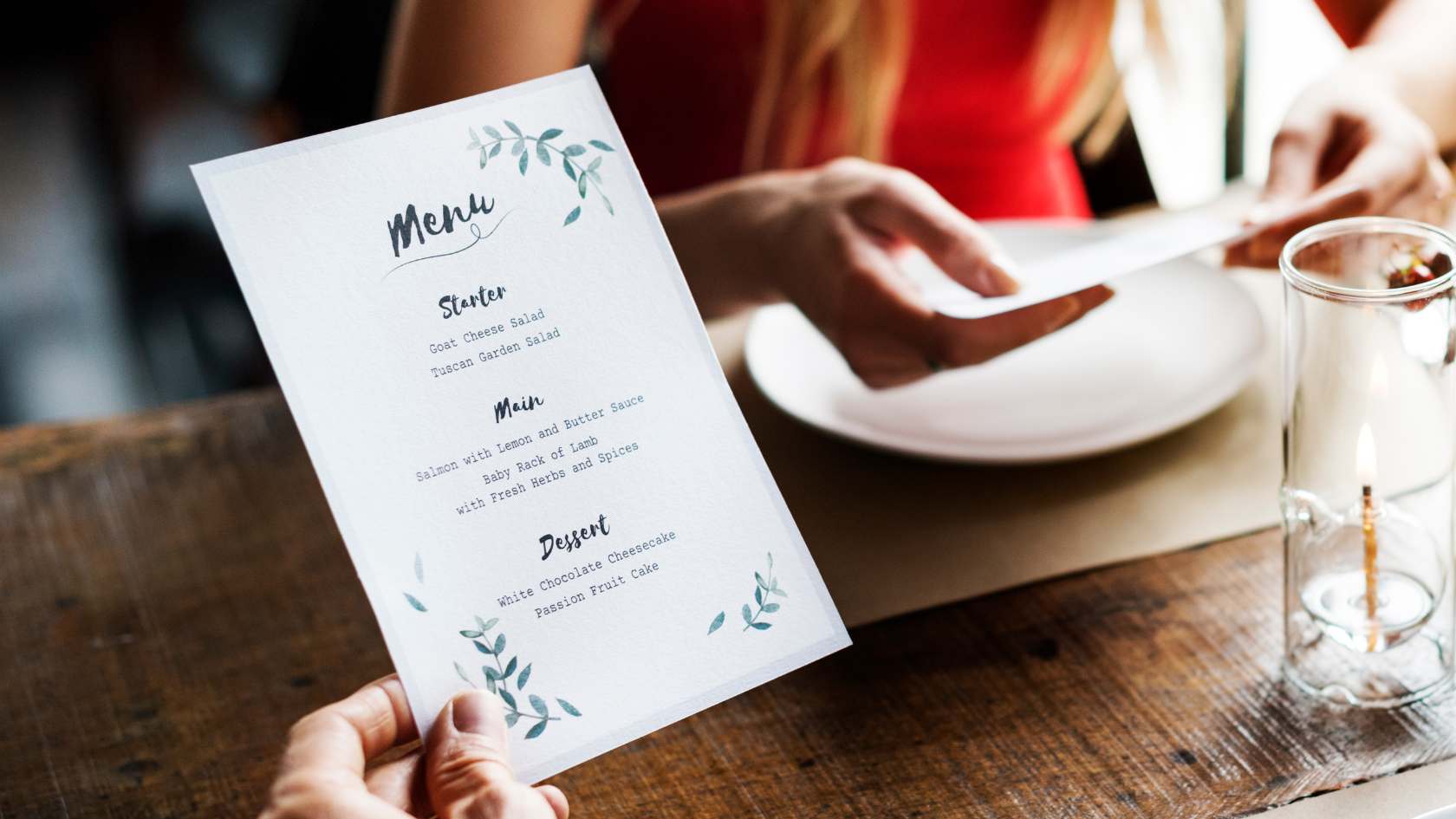11 Restaurant Menu Design Tips to Optimize Your Menu

Let’s talk about something that’s near and dear to every restaurant owner’s heart – the almighty menu design, What makes the perfect menu design? Your restaurant menu plays a significant role in conveying your brand, impressing your guests, and enticing them into what they will order. A well-designed menu , both in digital and printed format, is an essential piece of marketing and it’s often the first thing customers engage with. Let’s explore the main elements that make up a well-designed menu, what to avoid during the process, and how to best work with a designer for your desired result.
By following these curated tips, you can craft a restaurant menu that not only looks great, but also drives sales and provides an exceptional customer experience.
What are Important Factors When Designing a Menu?
- Branding and Theme: Ensure that your menu design aligns with your restaurant’s brand identity and overall theme. Consistency in design elements such as colors, fonts, and imagery helps reinforce brand recognition.
- Menu Structure: Organize your menu in a logical and intuitive manner, grouping similar items together and considering categorization (e.g., appetizers, entrees, desserts) for easy navigation.
- Visual Appeal: Incorporate high-quality images of your dishes to visually stimulate appetite and entice customers. Pay attention to layout, spacing, and typography to create a visually appealing document. Use clear and legible fonts, appropriate font sizes, and adequate spacing to ensure that customers can easily read and understand the menu, even in low-light conditions.
- Descriptive Language: Provide enticing descriptions for each dish to help customers imagine the flavors and ingredients, guiding their decision-making process.
- Formatting: Use high quality materials for printed menus. Use accessible, convenient, and easy-to-use digital menus.
How to Design a Menu for a Restaurant
1. Know Your Audience
No matter if you are developing your menu for the very first time or revising it, it is crucial to understand your target customers’ preferences, demographics, and dietary restrictions to tailor your menu accordingly. Perhaps your menu will be vegetarian or maybe you’ll focus on families. Also consider different menus for different audiences. If you restaurant provides takeout, catering, large groups, or events, you might have several different menus. Menu design can be thoughtfully translated into different versions of your menus but understanding your guests is key.
2. But First, Content
Before you even begin the design process for your restaurant’s menu, it’s crucial to spend time crafting the copy – the written content that will appear on the menu. The words, descriptions, and messaging you choose play a major role in how your menu resonates with your guests and drives sales. Start by clearly defining your restaurant’s cuisine, signature dishes, and unique selling points. Then, work on writing compelling, mouth-watering item descriptions that highlight the key flavors, ingredients, and preparation methods. Consider adding helpful context, such as the origins of a particular dish or the inspiration behind a cocktail. You’ll also want to thoughtfully determine how to position and price your offerings. Only once you have a solid foundation of well-written, strategic menu copy should you move forward with the visual design. This ensures your menu’s look and feel seamlessly complement the content, resulting in a cohesive, high-impact customer experience.
3. Organization and Headings
Organize the items into sections such as appetizers, main courses, desserts, or other relevant categories. Next, prioritize which menu items you want to feature prominently. Maybe you’d like appetizers to take the lead, and you may want a specific appetizer to shine at the top due to high profitability and popularity. Use clear, informative headers. Make it easy for customers to navigate your menu by using straightforward section titles like “Entrees”, “Beverages”, “Specials of the Day”, etc.
4. Use Fabulous Fonts
Typography can be a tool for conveying your brand aesthetic in a clear, direct way. Use strategic font sizing and styling. When the font is too small, it can polarize the guest. Many designers love negative space, but restaurants are often dark, and no one wants to take out their glasses or cell phone just to read the menu. Make your menu easy to read by using a clean, legible font with larger sizing for section headers and item names. Save smaller text for descriptions.
5. Keep It Concise
Ah, the age-old question that has restaurant owners scratching their heads – how long should that menu really be? Less is more and you don’t want to overwhelm your guests with a novel-sized menu. Generally, it is best practice to stick to aproximately 8-12 main dishes, and add a few app and dessert options. By offering a menu that’s not too exhaustive to read, you can make your restaurant a hospitable environment for your guest.

6. Revisit to Improve Content and Layout
Make good use of every word on your menu. While you initially drafted your menu, or you hired a copywriter, its wise to revisit your content. Seek advice from the chef or bartender responsible for crafting the menu items and reflect on the narrative accompanying each meal and each beverage offering. Make sure to encorporate adjectives in your menu and create a emotional resonance in your descriptions. Do any of your dishes need a short explanation? Are your special items getting the attention they deserve? Draw attention to your house specialties or seasonal offerings by placing them at the top of a section or featuring them in a separate callout box.
7. Align Your Restaurant Brand and Experience
This may seem like a no-brainer, but this advice goes beyond making sure your restaurant’s brand is front and center on the menu. Your menu design should align with and reinforce your overall brand identity, from the color scheme to the imagery used. Focus on fun details that will make your menu memorable.
8. List Ingredients and Dietary Info
Help customers make informed choices by including details on allergens, spice levels, vegan/vegetarian options, and any other key ingredients. Guests are more apt to order something if they understand what they are ordering.
9. Use Eye-catching Colors and Images
Opt for a color scheme for your menu that reflects your restaurant brand. High-quality photos of your most visually appealing dishes can help boost sales and get customers’ mouths watering. Even subtle graphics provide an opportunity to break up your content. Make sure to not over-do it with images and avoid stock photos.
10. Price Items Strategically
When updating an existing menu, take advantage to revisit your menu pricing and evaluate them critically. Adopt the perspective of your customers. With insights from your restaurant’s sales data, consider if adjusting the price of certain menu items slightly could enhance their appeal. List prices in a consistent way (e.g. with dollar signs, rounded to the nearest whole number) and price your items to maximize profit margins.
11. Test and Refresh Regularly
Testing and updating restaurant menus is a pivotal process in maintaining customer satisfaction. Use your creativity, sales data analysis, and customer feedback. To start, it’s crucial to conduct thorough market research, analyzing industry trends and customer preferences. Collaborating with your chefs and culinary experts to develop innovative dishes that align with the restaurant’s theme and target demographic is essential. Pilot testing these new menu items in limited release or as specials allows for real-time feedback collection. Leveraging customer surveys, online reviews, and social media interactions helps gauge the reception of these new offerings. Regularly updating menus based on this feedback loop ensures a dynamic dining experience, keeping your guests engaged and excited to return. Moreover, maintaining a balance between classic favorites and novel creations ensures a diverse menu that appeals to a broad spectrum of tastes. Finally, transparency in communication about menu changes fosters trust and loyalty among customers, enhancing the overall dining experience.
By incorporating these tips into your menu design process, you can create a visually appealing and informative menu that enhances the dining experience for your customers and drives sales for your business. Have fun with it — your menu is what makes you stand out!
Ready to Grow Your Event Business?
Schedule a Tripleseat demo to take a closer look at our event management features.
